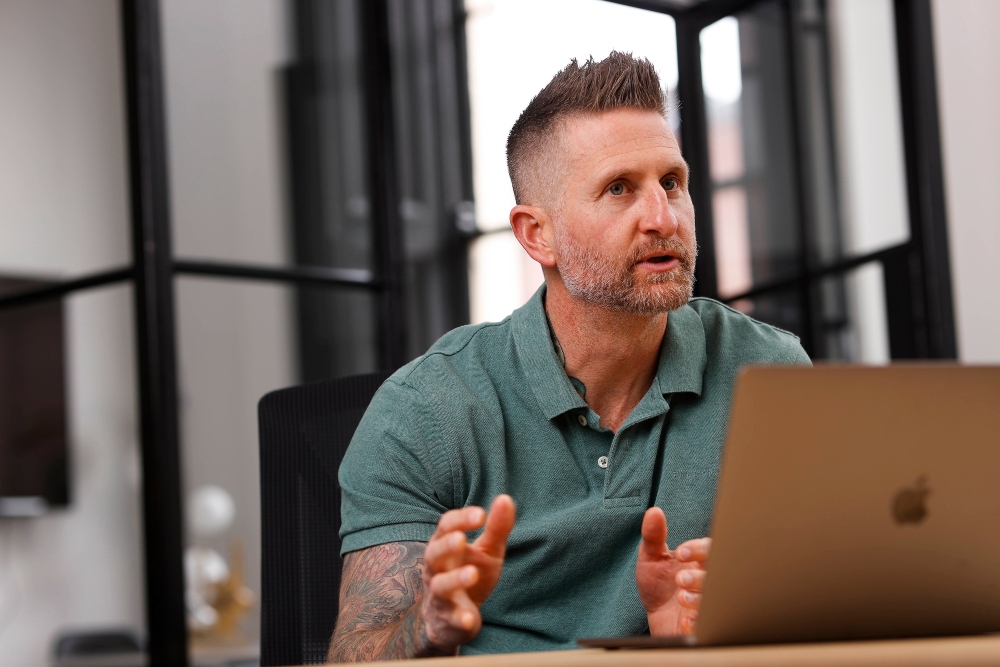Elaine Devereux from Lucky Beard explains how businesses can plan and execute a successful digital transformation journey.
Digital transformation is one of the most urgent business trends for the years ahead.
According to IDC, global spending on digital transformation projects will double between 2020 and 2025, reaching $2.8trn.
“Transformation takes time, resilience, and dedication. Getting fit for a digital future takes practice, day in, day out. Like any fitness regime, there will be stumbles and strains”
It’s partly a response to the rapidly accelerating digital world we find ourselves in after Covid-19, and also to meet the heightened expectations of customers.
So how can businesses ensure their investment has the best chance of success? Here are nine ways to ensure a digital transformation strategy delivers on its promise.
1. First start with the ‘why’, not the ‘what’
As the saying goes, if you don’t know where you’re going, any road will take you there. The first and most crucial step in the process is to figure out where you want to go as a business, and your reasons for doing so. Start with provocative questions that dig into the purpose of what you’re trying to achieve. Ask what you want your brand’s legacy to be, five or ten years from now. Ask why your employees come to work each day. Ask why your customers should stay loyal to your brand. When you ask the right questions and visualise the future, the answers become what we call the North Star, always there to guide you.
Now we come to the who: who is involved and has a stake in this. At Lucky Beard, we believe in involving core stakeholders in the process from the beginning: starting with the C-suite and branching out from there. We blend our approach by speaking to people throughout the business who are involved at key touchpoints in the customer journey, whether they are answering phones or interacting in other ways. Then we look under the bonnet with the CTO and core technology team to understand the systems, processes, legacy processes, technology and underlying architecture. This helps to see what will set the boundaries going forward. And the third element: we talk to existing or prospective customers so we can champion their voice.
2. Next, figure out the ‘what’
We’re not finished with the questions at this point. Ask what you want customers to say about you. Ask what the service or product should ‘feel’ like, from their perspective. Customer experience is becoming fundamental to brands’ growth: think of the tech unicorns like Amazon, Deliveroo or financial startups like Monzo and Revolut shaking up the banking market. They’re doing it by setting the benchmark for delivering great customer experiences that make things easy: three clicks and you’re done. The app generation that’s now your customer segment has high expectations. It’s up to you to meet them.
3. Then, plan the ‘how’
This is your roadmap to get there – with the caveat that your mileage may vary. It might be two, three or five years. (You’re only getting warmed up in year one.) The plan should focus on execution. Set regular milestones along the way: the goal should never be so far off in the distance that it feels like you’ll never get there.
There’s another valuable reason not to fixate on an endpoint: the plan is not finite. Digital is dynamic, never static, and it needs to be continuously optimised. Once we put something in the customer’s hands, we use analytics tools to listen to what they are saying. The plan needs to be flexible enough to respond to changes in technology, like VR (virtual reality), or NFTs.
4. Break the plan down into bite-sized pieces
Sometimes, seeing the entire roadmap is intimidating, so it’s important to break it down into manageable amounts. Start small and begin to make the vision a reality. Two-month sprints are enough to make measurable progress, produce a version and get it into customers’ hands sooner than later. You can optimise later; their feedback will inform what you need to test and improve for the next version.
This stage is all about balancing ambition and practicality: what are the first two or three initiatives that would nudge the customer experience to be a little better? It shows the customers, you’re listening to them. Just as importantly, these quick wins give the transformation team the confidence that change is possible.
5. Hire the best team
Assess your people’s capacity and capability to help you craft the right team to deliver digital transformation. You can’t be complacent when it comes to people. Sometimes you have to interview 50 people to hire one. Does your team have exceptional people with the right mindset and the right skill set?
By mindset, I mean the attitude of mucking in, getting things done, being a team player and coming to work with a positive attitude every day.
For skills, always invest in your people: this is non-negotiable. If they need additional training, skill them up – continuously. Watch for people’s ability to move sideways into complementary roles: you might have a UX designer who turns out to be great at hosting customer workshops. At Lucky Beard, we look for exceptional people – those who fit into our no-nonsense culture and someone who rolls up their sleeves, gets work done and respects their colleagues.
6. Culture is critical
Culture is not an add-on; it’s the heart and soul of why your people will follow your lead and commit to those tireless days, long months and years that digital transformation takes. It’s all about the right attitude: you need to foster a culture of curiosity and a willingness to always learn. (As I mentioned earlier, technology is always evolving, so you need people who are comfortable with change.) The culture needs to be collaborative. There’s no room for ‘I’ in digital transformation. It’s a massive team effort, not just the C suite. You need change makers, risk takers and people who will embrace the new. And you need undying commitment to championing the customer.
Having a firm framework about how you transform is essential, otherwise change can be chaotic. It needs a solid steering committee to lead it, and the right choice of partners to come with you. Be aware of how the change will impact the organisation. If you’re a legacy player in your market, you might need strategic advisory or organisational change agency that can deliver leadership training on culture and transition. Then you’ll need a partner that’s grounded in the latest development technologies and experience design, and a partner to handle your go-to-market for content and digital marketing.
7. Secure funding early – and think big
Digital transformation is about working in continuous streams, keeping up the pace, and always releasing new versions. These are not projects in the old sense of the word. They’re dynamic pieces of work that are constantly being optimised. That’s why it’s vital to secure at least 12 months’ rolling budget and ideally three years out. This avoids the endless fundraising that can the work to stall, killing momentum and strangling innovation. Digital disruptors are all working this way: setting key milestones and KPIs that build confidence, without being held back by a constant stop-start approach that relies on the next tranche of funding.
8. Don’t let the bumps get you down
Transformation takes time, resilience, and dedication. Getting fit for a digital future takes practice, day in, day out. Like any fitness regime, there will be stumbles and strains. With a strong culture that’s oriented towards learning and evolving, you’ll see these moments for what they are: not insurmountable obstacles to progress but opportunities to learn, dust yourself off, and go again.
9. Have fun along the way
When you have a culture that’s open to change, you can enjoy the ride rather than anticipating the risks around every corner. At Lucky Beard we foster a team spirit that celebrates the wins and have a sense of humour about what we do. And returning to our first point, remembering the ‘why’ will be what sustains the team.




